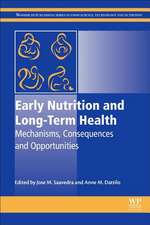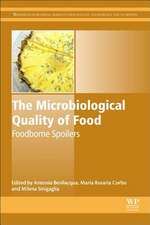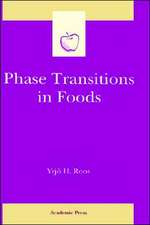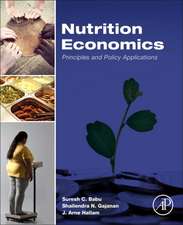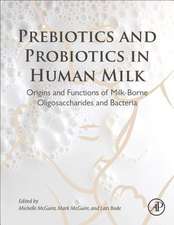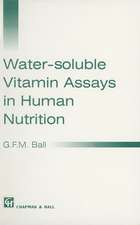Metabolomics as a Tool in Nutrition Research: Woodhead Publishing Series in Food Science, Technology and Nutrition
Editat de J-L Sebedio, L Brennanen Limba Engleză Hardback – 7 dec 2014
Din seria Woodhead Publishing Series in Food Science, Technology and Nutrition
- 15%
 Preț: 391.19 lei
Preț: 391.19 lei - 24%
 Preț: 1333.02 lei
Preț: 1333.02 lei - 24%
 Preț: 1210.03 lei
Preț: 1210.03 lei - 24%
 Preț: 946.43 lei
Preț: 946.43 lei - 9%
 Preț: 1205.99 lei
Preț: 1205.99 lei - 24%
 Preț: 1189.10 lei
Preț: 1189.10 lei - 9%
 Preț: 984.09 lei
Preț: 984.09 lei - 9%
 Preț: 1006.66 lei
Preț: 1006.66 lei - 24%
 Preț: 960.56 lei
Preț: 960.56 lei - 23%
 Preț: 1419.50 lei
Preț: 1419.50 lei - 9%
 Preț: 1206.85 lei
Preț: 1206.85 lei - 9%
 Preț: 922.07 lei
Preț: 922.07 lei - 24%
 Preț: 1192.22 lei
Preț: 1192.22 lei - 9%
 Preț: 1215.75 lei
Preț: 1215.75 lei - 24%
 Preț: 1162.37 lei
Preț: 1162.37 lei - 9%
 Preț: 950.09 lei
Preț: 950.09 lei - 24%
 Preț: 1162.62 lei
Preț: 1162.62 lei - 24%
 Preț: 801.31 lei
Preț: 801.31 lei - 27%
 Preț: 379.84 lei
Preț: 379.84 lei - 29%
 Preț: 1336.07 lei
Preț: 1336.07 lei - 24%
 Preț: 798.74 lei
Preț: 798.74 lei - 9%
 Preț: 1018.93 lei
Preț: 1018.93 lei - 24%
 Preț: 1081.43 lei
Preț: 1081.43 lei - 24%
 Preț: 1185.22 lei
Preț: 1185.22 lei - 24%
 Preț: 1131.77 lei
Preț: 1131.77 lei - 23%
 Preț: 1635.86 lei
Preț: 1635.86 lei - 9%
 Preț: 1277.62 lei
Preț: 1277.62 lei - 24%
 Preț: 1049.04 lei
Preț: 1049.04 lei - 24%
 Preț: 1134.60 lei
Preț: 1134.60 lei - 9%
 Preț: 1076.36 lei
Preț: 1076.36 lei - 24%
 Preț: 1158.21 lei
Preț: 1158.21 lei - 9%
 Preț: 1065.06 lei
Preț: 1065.06 lei - 9%
 Preț: 1067.39 lei
Preț: 1067.39 lei - 24%
 Preț: 812.03 lei
Preț: 812.03 lei - 9%
 Preț: 1203.13 lei
Preț: 1203.13 lei - 23%
 Preț: 1237.19 lei
Preț: 1237.19 lei - 24%
 Preț: 948.79 lei
Preț: 948.79 lei - 23%
 Preț: 1138.06 lei
Preț: 1138.06 lei - 9%
 Preț: 868.43 lei
Preț: 868.43 lei - 24%
 Preț: 871.98 lei
Preț: 871.98 lei - 20%
 Preț: 1272.59 lei
Preț: 1272.59 lei - 29%
 Preț: 1195.06 lei
Preț: 1195.06 lei - 9%
 Preț: 1045.58 lei
Preț: 1045.58 lei - 9%
 Preț: 1002.45 lei
Preț: 1002.45 lei - 9%
 Preț: 505.72 lei
Preț: 505.72 lei - 9%
 Preț: 1062.13 lei
Preț: 1062.13 lei - 24%
 Preț: 1306.94 lei
Preț: 1306.94 lei
Preț: 922.77 lei
Preț vechi: 1346.94 lei
-31% Nou
Puncte Express: 1384
Preț estimativ în valută:
176.58€ • 188.82$ • 147.22£
176.58€ • 188.82$ • 147.22£
Carte tipărită la comandă
Livrare economică 10-24 aprilie
Preluare comenzi: 021 569.72.76
Specificații
ISBN-13: 9781782420842
ISBN-10: 1782420843
Pagini: 268
Dimensiuni: 152 x 229 x 22 mm
Editura: ELSEVIER SCIENCE
Seria Woodhead Publishing Series in Food Science, Technology and Nutrition
ISBN-10: 1782420843
Pagini: 268
Dimensiuni: 152 x 229 x 22 mm
Editura: ELSEVIER SCIENCE
Seria Woodhead Publishing Series in Food Science, Technology and Nutrition
Cuprins
- List of contributors
- Woodhead Publishing Series in Food Science, Technology and Nutrition
- Preface
- Part One: Principles
- 1. Challenges in nutritional metabolomics: from experimental design to interpretation of data sets
- Abstract
- 1.1 Introduction
- 1.2 The experimental design
- 1.3 The analytical platform
- 1.4 Extraction of data sets and statistical analyses
- 1.5 Metabolite identification
- 1.6 Biological interpretations
- 1.7 Conclusion: do we need standardisation procedures and repositories?
- 2. Metabolic profiling as a tool in nutritional research: key methodological issues
- Abstract
- 2.1 Introduction
- 2.2 Key issues in nutritional research
- 2.3 The role of genomics, proteomics, metabolomics, and metagenomics in nutritional research
- 2.4 Applications of metabolomics in nutrition-related research
- 2.5 The use of metabolomics to assess the effects of diet on health
- 2.6 Methods for mapping dietary patterns
- 2.7 Observational and interventional studies into the effects of diet and nutrition on health
- 2.8 Analytical methods
- 2.9 Issues in analysing samples
- 3. Chemometrics methods for the analysis of genomics, transcriptomics, proteomics, metabolomics, and metagenomics datasets
- Abstract
- 3.1 Introduction
- 3.2 Unsupervised and supervised pattern recognition methods
- 3.3 Multivariate calibration methods for developing predictive models
- 3.4 Statistical data integration methods
- 3.5 Data integration: multiblock strategies
- 3.6 Data integration: calibration transfer methods
- 3.7 Data integration: multiway/multimodal analysis methods
- 3.8 Data integration: correlation-based approaches
- 3.9 Data integration: techniques for analysing different types of genomics datasets
- 3.10 Statistical data integration of different sample types
- 3.11 Statistical data integration of different molecular components in samples
- 3.12 Modelling relationships between molecular components
- 3.13 Conclusion and future trends
- 1. Challenges in nutritional metabolomics: from experimental design to interpretation of data sets
- Part Two: Applications in nutrition research
- 4. Application of lipidomics in nutrition research
- Abstract
- Acknowledgement
- 4.1 Introduction
- 4.2 Lipids
- 4.3 Lipidomics
- 4.4 Lipidomics in nutrition research
- 4.5 Conclusion and future trends
- 5. Analysing human metabolic networks using metabolomics: understanding the impact of diet on health
- Abstract
- Acknowledgements
- 5.1 Introduction
- 5.2 Metabolic network reconstruction
- 5.3 Human metabolic networks
- 5.4 Linking metabolomics data and metabolic network elements
- 5.5 Metabolism modelling, from pathways to network
- 5.6 Subnetwork extraction between identified metabolites
- 5.7 Conclusion and future directions
- 6. Using metabolomics to analyse the role of gut microbiota in nutrition and disease
- Abstract
- 6.1 Introduction: gut microbiota and human health
- 6.2 Metagenomics of gut microbiota
- 6.3 Metabolomics: uncovering complex host–microbe interactions
- 6.4 The marriage of metagenomics and metabolomics: microbiome–metabolome interactions
- 6.5 Future perspectives: personalised nutrition
- 7. Metabotyping: moving towards personalised nutrition
- Abstract
- 7.1 Introduction
- 7.2 The concept of the metabotype
- 7.3 Examples of metabotyping with a focus on nutrition
- 7.4 Extension of metabotypes to include markers of dietary origin
- 7.5 Conclusion and future trends
- 7.6 Sources of further information and advice
- 8. Using metabolomics to identify biomarkers for metabolic diseases: analytical methods and applications
- Abstract
- 8.1 Introduction
- 8.2 Using metabolomics to understand the relationship between nutrition and chronic metabolic diseases
- 8.3 Cohort studies and biomarker identification
- 8.4 Isolating in situ biomarkers
- 8.5 Conclusions and future trends
- 9. Using metabolomics to evaluate food intake: applications in nutritional epidemiology
- Abstract
- 9.1 Introduction
- 9.2 Biomarkers as a complementary approach to questionnaires
- 9.3 Definition of the food metabolome
- 9.4 Metabolomics as a tool for dietary biomarker discovery
- 9.5 Dietary patterns and metabolomic profiles: potential use of nutritypes
- 9.6 Validation of putative biomarkers
- 9.7 The future of metabolomics in dietary assessment
- 9.8 Conclusion
- 10. Metabolomics and nutritional challenge tests: what can we learn?
- Abstract
- 10.1 Introduction
- 10.2 Application of metabolomics to challenge tests
- 10.3 Conclusion and future trends
- 11. Using metabolomics to describe food in detail
- Abstract
- 11.1 Introduction
- 11.2 Using metabolomics to assess the effects of genetic selection and modification
- 11.3 Using metabolomics to assess the effects of organic versus conventional farming
- 11.4 Using metabolomics to identify the geographical origin of food products
- 11.5 Using metabolomics to assess the effects of rearing conditions on the quality of meat, eggs, and fish
- 11.6 Using metabolomics to assess the effects of processing on food quality
- 11.7 Using metabolomics to assess the effects of digestion on nutrient intake from particular foods
- 11.8 Conclusion
- Appendix: abbreviations
- 12. Future perspectives for metabolomics in nutrition research: a nutritionist’s view
- Abstract
- 12.1 Introduction
- 12.2 Metabolites identification and biological relevance
- 12.3 In vivo metabolomics
- 12.4 Conclusion
- 4. Application of lipidomics in nutrition research
- Index

